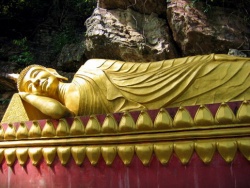Sleeping lion's posture
Sleeping lion's posture (Wyl. seng ge'i nyal stabs?) —
Sogyal Rinpoche writes:
- Traditionally the position generally recommended for dying is to lie down on the right side, taking the position of "the sleeping lion," which is the posture in which Buddha died. The left hand rests on the left thigh; the right hand is placed under the chin, closing the right nostril. The legs are stretched out and very slightly bent. On the right side of the body are certain subtle channels that encourage the "karmic wind" of delusion.[1] Lying on them in the sleeping lion's posture, and closing the right nostril, blocks these channels and facilitates a person's recognition of the luminosity when it dawns at death. It also helps the consciousness to leave the body through the aperture at the crown of the head, as all the other openings through which it could leave are blocked.[2]
Footnotes
- ↑ We need to bear in mind that most traditional texts [and modern ones too!] are written by males for a male readership rather than for the female. So here, when it mentions the position for lying down, we need to bear in mind that this is from the perspective of a male. So for men, it’s the right channel which is connected to the disturbing energies—the “karmic wind” of delusion—but for women, it’s the left channel, so women need to mirror the above position. Alak Zenkar Rinpoche has confirmed that for women, the arrangement of the channels is reversed, so that women should lie on their left side, and so on.
- ↑ The Tibetan Book of Living and Dying, page 255.
Further Reading
- Dzogchen Ponlop, Mind Beyond Death (Ithaca: Snow Lion Publications, 2006), pages 78-79.
- Sogyal Rinpoche, The Tibetan Book of Living and Dying, pages 235, 255, 270 & 274
- Tsele Natsok Rangdrol, Mirror of Mindfulness (Boston & Shaftesbury: Shambhala, 1989), page 36.
Source
RigpaWiki:Sleeping lion's posture
As at night, it was the Buddha's habit to lie in the lion posture (sihasana) on his right side, with one hand under his head and the feet placed on each other. The Buddha recommended a posture he called "lion's pose" which is simply lying on the right side with the right arm cradling the head, the left arm along the side, and the left leg bent at the knee, with the left foot lying in the arch of the right foot. Shivasana is lying flat on the back with legs about shoulder width apart and arms by the sides, with hands about a fist distance from the body, and palms turned up. This is the same position that Guru Shakyamuni Buddha had when he passed away. Keep the right side perfectly on the bed, then put the right hand under the right cheek. Keep both of the legs straight, then stretch the left arm along the left leg. If there is an altar, the legs should not be stretched towards the altar. The head should be towards the altar. Usually it’s better not to have altars completely all around the bedroom in our house. That way it’s difficult to stretch the legs, because it prompts disrespect and we are committing negative karma. Wherever we stretch our legs, don’t put an altar on that side.
lion posture’ (sīhāsana)
